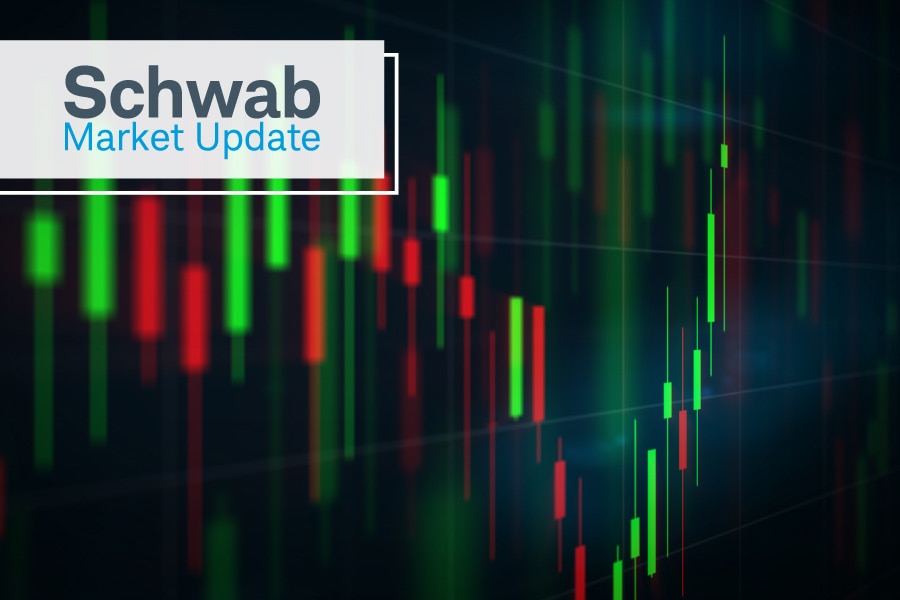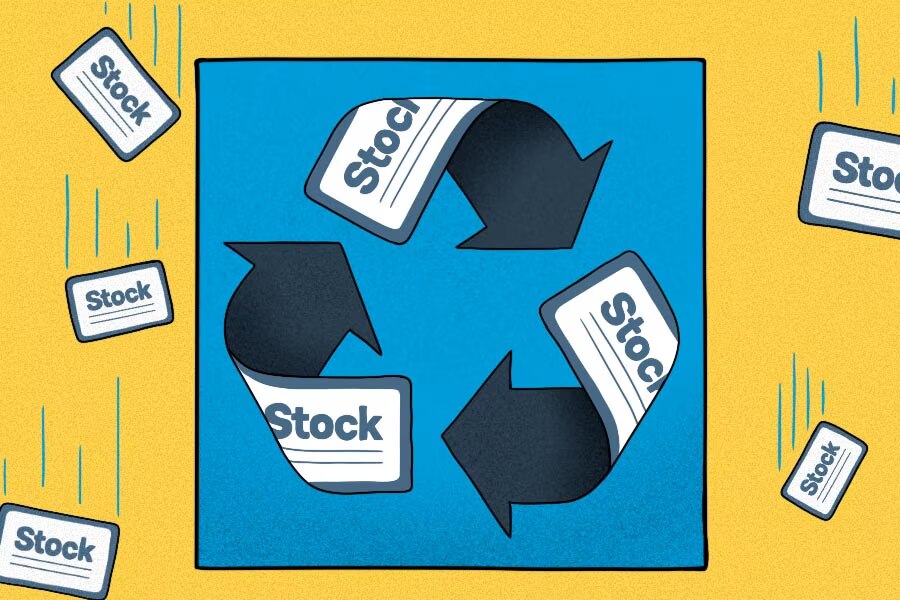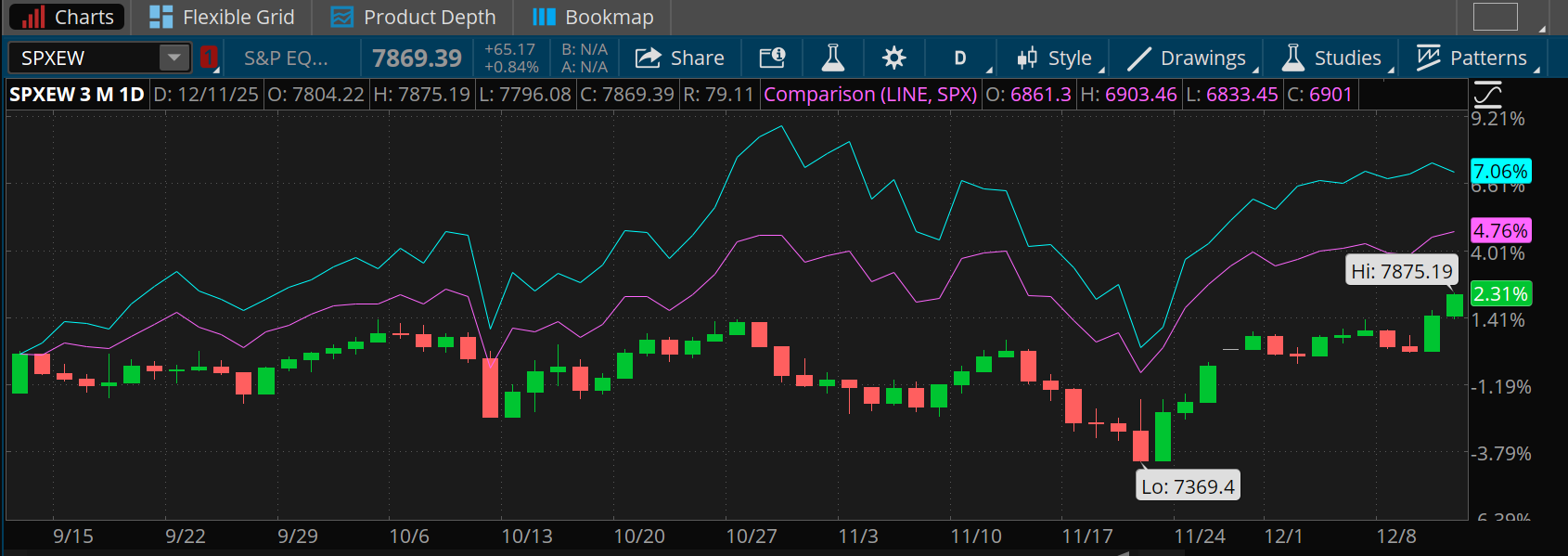Rotation Out of Tech Rolls Along as Broadcom Dips

Published as of: December 12, 2025, 9:15 a.m. ET
Listen to this article
Listen here or subscribe for free to the Schwab Market Update in your favorite podcast app.
| The markets | Last price | Change | % change |
|---|---|---|---|
| S&P 500® index | 6,901.00 | +14.32 | +0.21% |
| Dow Jones Industrial Average® | 48,704.01 | +646.26 | +1.34% |
| Nasdaq Composite® | 23,593.85 | -60.30 | -0.26% |
| 10-year Treasury yield | 4.18% | +0.04 | -- |
| U.S. Dollar Index | 98.45 |
+0.10 |
+0.10% |
| Cboe Volatility Index® | 14.96 | +0.11 | +0.74% |
| WTI Crude Oil | $57.64 | +0.04 | +0.07% |
| Bitcoin | $92,585 | +$575 |
+0.62% |
(Friday market open) Judging from the calendar, this could be a day Wall Street takes a breather from its recent feverish pace. Major earnings and data are scarce, the weekend beckons, and investors increasingly look ahead to next Tuesday's jobs report. Broadcom (AVGO) dominates the scenery after results and guidance late Thursday topped estimates, though shares dropped and took the Nasdaq down in early trading.
Investors' early reaction to Broadcom suggests the AI crowd is getting tough to please. Arguably, the chip maker's earnings exceeded most expectations, but shares fell nearly 6% ahead of the open. Broadcom had rallied 200% from its April low through yesterday's close, meaning good news may already be priced in. Checking quarterly numbers, Broadcom's revenue rose 28.2% year over year to $18.02 billion, easily topping consensus of $17.47 billion, and it sees positive momentum continuing. However, analysts on the company's call appeared skeptical about the forecasts, Barron's reported. Broadcom's performance so far today following Oracle's (ORCL) slide yesterday fits into theories that investors are shifting their focus beyond tech amid growing AI spending worries.
Major indexes had a mixed outing Thursday. The Dow Jones Industrial Average and S&P 500 index posted record-high closes while the Nasdaq wilted. Tech's weakness reinforces ideas that rotation continues out of AI names and into sectors like small caps and financials, something to track today amid rising Treasury yields that can hurt smaller stocks. "The combination of the Fed's updated dot plot—which included higher GDP growth and slightly lower inflation expectations—coupled with Oracle's increased CapEx spending, appears to be contributing to continued money flow towards more cyclical, non-tech areas of the market," said Nathan Peterson, director of derivatives research and strategy, Schwab Center for Financial Research (SCFR).
To get the Schwab Market Update in your inbox every morning, subscribe on Schwab.com.
Three things to watch
- Jobs report looms, expectations low: Nonfarm payrolls data Tuesday will be the first in more than two months due to the government shutdown, and investors head in with grim views. The report will feature numbers from both October and November and is expected to show creation of about 10,000 and 55,000 jobs, respectively, according to Trading Economics. That's down from an already diminished 119,000 in September and follows some negative monthly job reports earlier this year. The October part won't include household data, meaning no unemployment number for that month. "If the labor market continues to soften at the margin, inflation stays sticky, and affordability doesn't improve, consumption might look less robust in 2026 compared to 2025," warned Liz Ann Sonders, chief investment strategist, SCFR, and Kevin Gordon, head of macro research and strategy, SCFR, in a recent podcast. "That especially rings true if companies' increased investment doesn't lead to a surge in hiring—which is possible if the desire is to invest more in technological, as opposed to human, capital."
- Could anemic jobs data be too optimistic? Federal Reserve Chairman Jerome Powell said in his press conference Wednesday he believes there's a "systemic overcount" in monthly job growth data in the range of 60,000 a month. That implies future downward revisions once data get adjusted. If he's right, it would mean a monthly job gain of 50,000 is a loss of 10,000 thatmakes its way into data down the road. Powell is influential, so it wouldn't surprise if his words resonate. That said, the Fed's economic projections paint a rosy picture for 2026 and 2027. Unemployment is seen down slightly at 4.4% next year from the projected 4.5% level this year. "The economic backdrop is rather firm," said Gordon. "And that might sound counterintuitive, but it mostly boils down to the fact that we still have this split between the hard data—or actual economic data like GDP—and the soft data, such as anything that's just survey-based."
- Market marks time, seeking catalysts: Checking under the hood, Wall Street looks relatively healthy but doesn't appear ready to re-ignite. About 54% of S&P 500 stocks are trading above their 50-day moving averages, which is near normal for market breadth and a sign that rotation into stocks beyond mega caps continues but not at a frantic pace. Advancing shares narrowly outpaced declining ones through midday Thursday this week, and the momentum-indicating Relative Strength Index (RSI) was around 60 on Thursday. That's below the 70 level typically seen as overbought. However, RSI shows signs of divergence, indicating chances of a possible trend reversal. The Average Directional Index (ADX), which can help investors assess the strength of a trend, is 16, showing little conviction, and hedging activity is low, in the 39th percentile historically. All signs point to a consolidating market waiting for its next catalyst. Besides the jobs report and consumer price data next week, there aren't a lot of obvious catalysts ahead. A couple to watch include a possible Supreme Court ruling on tariffs and growing anticipation that the Bank of Japan will hike rates late next week.
On the move
Lululemon (LULU) soared 9.6% in pre-market trading after topping Wall Street's earnings per share and revenue estimates. The company also announced that CEO Calvin McDonald will be stepping down at the end of next month.
Broadcom fell today, but its report showed solid AI demand continued last quarter. AI semiconductor revenue rose 74% year over year, the firm said. One concern is the reliance of Broadcom and other large AI firms on orders from OpenAI, which still isn't profitable. This could explain why analysts have become skeptical about forecasts. The next major tech earnings aren't until January, so there might not be much data to mull on the AI front for a few weeks.
Weakness in Broadcom helped pull down shares of semiconductor firms this morning, including ASML (ASML), CoreWeave (CRWV), Arm Holdings (ARM), Advanced Micro Devices (AMD), Palantir (PLTR), and Super Micro Computer (SMCI), though none of the losses were dramatic.
Nvidia (NVDA) rose almost 1% ahead of the open after Reuters reported that the company is considering raising production of its H200 chip due to strong demand from China.
Alphabet (GOOGL) dropped more than 2% Thursday after OpenAI—which competes with Google's Gemini 3—announced a new AI model that the privately-held firm said is better at enterprise tasks. One thought, according to Investor's Business Daily, is that the new model could also challenge the employee productivity software market dominated by Microsoft (MSFT) and Google.
Speaking of OpenAI, in an interview Thursday on CNBC, CEO Sam Altman sounded open to eventually sharing information on the company's revenue. That would likely please investors worried about finances at the company that's so deeply wrapped into the AI space.
Tesla (TSLA) slipped 1% Thursday after Reuters reported that the carmaker's November U.S. sales hit a nearly four-year low.
RH (RH) climbed nearly 3% in pre-market trading after reporting better-than-expected quarterly revenue. The furniture company's earnings per share, however, missed consensus. Guidance also was below Wall Street's expectations.
Costco (COST) barely moved ahead of the open despite reporting better-than-expected revenue and earnings late Thursday. Sales rose 8.2% from a year earlier.
Materials, financials, and industrials topped the sector scorecard Thursday, while info tech fell more than 0.5%. Visa (V) and Mastercard (MA) were two of the biggest gainers, reflecting what appears to be a strong shopping season and hopes for more consumer spending next year in a lower rate and tax environment. However, inflation remains a concern, as Chicago Fed President Austan Goolsbee said today he still believes rates can come down but inflation progress has stalled.
Warner Bros Discovery (WBD) rose 1.5% amid a bidding war for the company between Paramount Skydance (PSKY) and Netflix (NFLX). Paramount launched a $108 billion hostile takeover bid for Warner Bros this week in an eleventh-hour attempt to prevent Netflix from acquiring the company.
Tilray Brands (TLRY) spiked 31% and other marijuana-related names including Cronos Group (CRON) also climbed after the Washington Post reported that President Trump plans to reclassify marijuana as a Schedule III drug, similar to some common prescription painkillers.
Bitcoin (/BTC) inched up 0.7% early Friday and crypto-related stocks rose marginally. Bitcoin futures have been skimming just above $90,000 for a few sessions, above November's low near $80,000 but far from the October peak of $127,000.
More insights from Schwab

Why stock buybacks matter: When companies repurchase their own stock, they return capital to shareholders by lowering their outstanding share count and boosting earnings per share. However, buybacks can also be controversial. Learn how they work, why companies use them, the risks involved, and how to evaluate them as an investor in our newest stocks feature.
Crystal ball for 2026: Schwab's latest OnInvesting podcast features Schwab experts discussing what investors might expect in 2026 across markets and the U.S. economy. "I think 10-year yields are going to have a tough time falling much below 4% unless we really can get inflation down," said Kathy Jones, chief fixed income strategist, SCFR.
Match of the day: If your employer offers a company match, when you contribute a portion of your salary to your 401(k) account, your company also provides a matching contribution to your plan, up to the annual contribution limit. Learn more about how this can help build your retirement savings in our latest beginner 401(k) article.
Chart of the day

Data sources. S&P Dow Jones Indices, Nasdaq. Chart source: thinkorswim® platform.
Past performance is no guarantee of future results.
For illustrative purposes only.
Over the last couple of weeks, the S&P 500 Equal Weight Index (SPXEW-candlesticks) has started to make progress against the S&P 500 index (purple line) and the Nasdaq 100 (blue line). This could reflect rotation out of tech and mega caps into smaller and more cyclical names and is a trend worth watching. Even so, the equal weight still trails the others in three-month performance.
The week ahead
Check out the investors' calendar for a summary of the top economic events and earnings reports on tap this week.
December 15: No major earnings or data expected.
December 16: November nonfarm payrolls, October retail sales, and expected earnings from Lennar (LEN).
December 17: Expected earnings from General Mills (GIS) and Micron (MU).
December 18: November CPI and core CPI, and expected earnings from Accenture (ACN), Cintas (CTAS), Carnival (CCL), Nike (NKE), and FedEx (FDX).
December 19: Final December University of Michigan consumer sentiment and expected earnings from Paychex (PAYZ), Lamb Weston (LW), and Conagra (CAG).